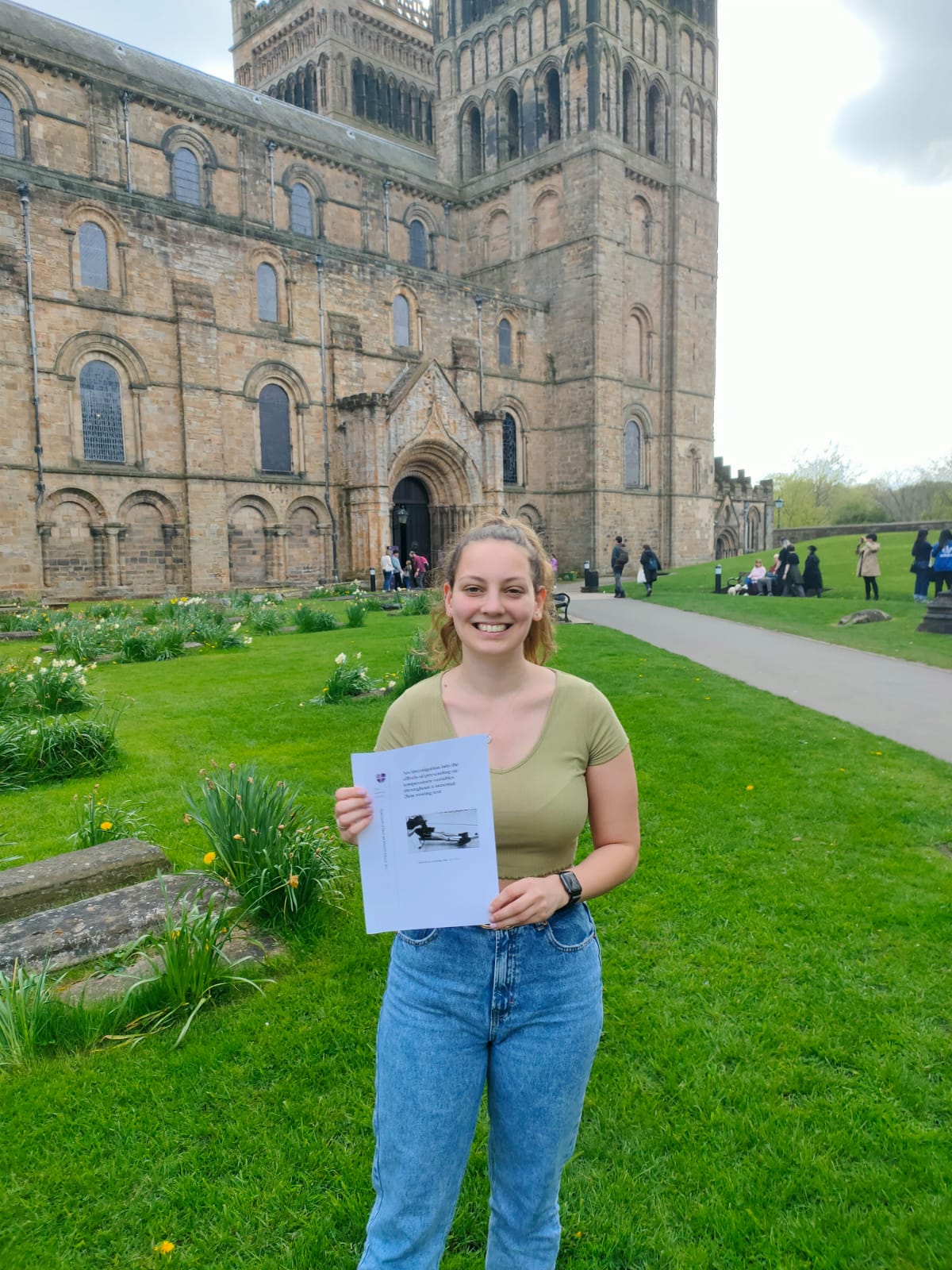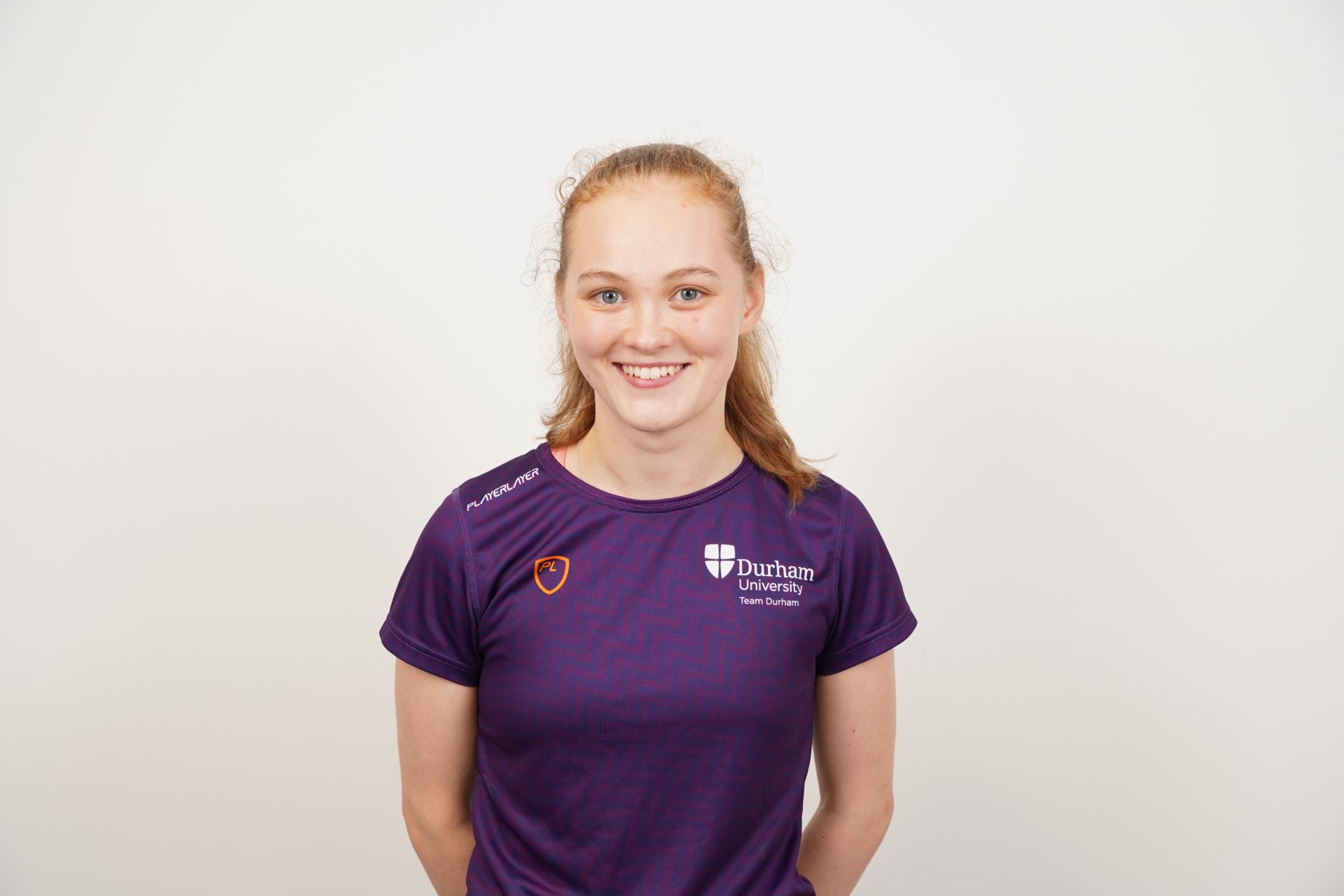Undergraduate Research Activities in the Human Performance Laboratory
Alex Norris
Level of Study: Undergraduate Dissertation
Project Title: Sex-based comparisons of energy system utilisation during simulated university football-match-play: A Quantitative Study.
Project Description: My research project aimed to simulate football-match-play in a controlled laboratory-based setting. Using this simulated play, I wanted to compare the between male and female participants to see if there were differences in the contribution and utilisation of the energy systems during the simulated football match. Additionality, the research examined whether a football-specific intermittent running protocol developed in male athletes was suitable to examine the metabolic demands of female university footballers.
How did the facilities in the Department of Sport and Exercise Sciences allow you to complete your work?
The facilities within the Sport and Exercise Sciences department allowed me to accurately measure the quantitative outcomes using highly valid laboratory equipment. This increased the quality of my dissertation project. Furthermore, being able to choose and use any equipment within the department made the experience during the creation of my dissertation very enjoyable.
What are your plans for next year?
I plan on pursuing a career in data analytics. I am unsure whether this will be specifically in the sport or private sectors. A large part of my dissertation involved the coding and analyses of large data sets to provide a quantitative outcome. Although challenging, I found this interesting and could see myself doing this as a career. Hopefully progressing to a data analytics director in the future.
Erika Davies
Level of Study: Undergraduate Dissertation
Project Title: The Comparison Between Isotonic Energy Gels and Drinks Prior to Training on Intermittent Exercise Output in Non-Elite University-Aged Footballers.
Project Description: My dissertation project aimed to look at how consuming energy drinks and energy gels can effect intermittent performance in team sports, such as football. In this case, intermittent exercise refers to all of the starting and stopping that happens within a football match.
How did the facilities in the Department of Sport and Exercise Sciences allow you to complete your work?
They were brilliant in allowing me to use the facilities when needed and provided me with help and guidance throughout the process.
What are your plans for next year?
I am working for a executive search recruitment firm!
Kara Milligan
Level of Study: Undergraduate Dissertation
Project Title: An investigation into the effects of pre-cooling on temperature variables throughout a maximal 2km rowing test
Project Description: The study aimed to explore the effects of wearing an ice vest on heart rate, thermal stress (stress in response to a change in temperature), and power output during a rowing test involving six male rowers. In the study, participants completed one trial involved wearing an ice vest and another in their regular clothing. . The result showed that wearing ice vests during rowing led to elevated heart rate but reduced skin temperature and power outputs. These findings suggest that the performance advantages of wearing an ice vest during a 2km test are limited.
How did the facilities in the Department of Sport and Exercise Sciences allow you to complete your work?
Utilizing state-of-the-art technology available in the sports science labs, I successfully measured various performance factors. Throughout the process, Rob Hunter, the department's knowledgeable lab technician, provided valuable guidance on optimal testing procedures.
What are your plans for next year?
Going to Edinburgh University to study a masters in environmental sustainability.
Throughout the process, Rob Hunter, the department's knowledgeable lab technician, provided valuable guidance on optimal testing procedure
Amy Lees
Level of Study: Undergraduate Dissertation
Project Title: The Effects of a 4-Week Plyometric Training Programme on Agility in Female Tennis Players: A Quantitative Study
Project Description: The aim of my project was to observe any effects of a plyometric training programme on agility within a university-aged sample of female tennis players. Plyometirc exercises use both speed and force to increase muscle power. With my participants, I completed pre-intervention testing where I measured not only agility but also power and reaction time. Following this initial round of testing, half of the participants were given a 4-week plyometric training programme I designed which consisted of two sessions per week. Once the training programme was completed, all participants were invited back for post-intervention testing where I repeated the same testing procedures initially conducted. I was then able to compare any differences in pre- and post-intervention scores.
How did the facilities in the Department of Sport and Exercise Sciences allow you to complete your work?
The facilities within the department allowed me to complete my pre- and post-intervention testing measures for all three components of fitness I chose to measure. Using the lab at Maiden Castle gave my study a greater level of control and meant that I could repeat testing procedures under the same conditions. The equipment in the lab also allowed me to run more valid and reliable fitness testing appropriate for my project.
What are your plans for next year?
Next year I hope to stay on at Durham and continue my interests in research by completing an MRes. Alongside this, I have also secured an internship as tennis coordinator for Team Durham.
Using the lab at Maiden Castle gave my study a greater level of control and meant that I could repeat testing procedures under the same conditions.
Anthony Webster
Level of Study: Undergraduate Dissertation
Project Title: Investigation of sex differences in acute cognitive responses to a repeated bout of soccer heading: a quantitative study
Project Description: My study focused on how we can evaluate the short-term effects of heading a soccer ball on cognitive response and concussion, adding to the limited research in this topic. Using cognitive testing I was able compare performance on these tests before and after heading the ball to see the immediate effects of the exercise for each individual participant and compare if there were any differences between the male and female participants. Preliminary research in this area suggest that female participant's performance on cognition tests is affected more negatively by heading compared to male participants.
How did the facilities in the Department of Sport and Exercise Sciences allow you to complete your work?
The facilities provided by the department allowed me to run cognitive testing battery that would not be financially viable independently. I also required the help of a lab technician at various points who was very helpful and facilitated the study for me.
What are your plans for next year?
My plans next year are to continue my studies at Durham, completing an MSc in Physical Activity, Health and Society with the departments of Sport and Exercise Sciences and Anthropology!
Tia Saxelby
Level of Study: Undergraduate Dissertation
Project Title: The effect of a passive half-time re-warm-up initiative in comparison to an active half-time re-warm-up initiative on the physiological responses of female intermittent athletes.
Project Description: The project assessed physiological responses, such as HR, following a half-time re-warm-up protocol, to determine if a passive, in warm bath, or active, cycling on a bike, protocol was more beneficial for performance. Both before and after the half-time re-warm-up protocol, participants completed a treadmill test which allowed for assessment of several biomarkers. The active re-warm-up, cycling on the bikes, was the superior mode of half-time re-warm-up.
How did the facilities in the Department of Sport and Exercise Sciences allow you to complete your work?
The human performance lab allowed me to complete my dissertation as it provided a wide variety of equipment which allowed for lots of data to be collected and different variables could be measured. Additionally, the support of the lab technician ensured participants were safe and happy at all times and this meant testing could run smoothly. I also feel the high-tech nature of the lab meant testing was easier, for example, I was able to pre-programme the treadmill meaning I could focus on other aspects of testing whilst the participant carried out the treadmill test.
What are your plans for next year?
Studying a MSc in physiotherapy (pre-registration) at Sheffield Hallam University.
Chelsea Penny
Level of Study: Undergraduate Dissertation
Project Title: Investigating the effects of different forms of caffeine on male sprinters performance: quantitative study.
Project Description: I investigated the effects of 200mg caffeine gum and 200mg caffeine shots on male sprinters performance. A a control condition, where no caffeine was taken, was included to see how much effect each form of caffeine had on the male sprinters' performance. As part of the study, I measured speed, 30 metre sprint time and reaction time.
How did the facilities in the Department of Sport and Exercise Sciences allow you to complete your work?
The facilities of the department allowed me to complete my dissertation work due to having the correct specialised equipment such as the SmartSpeed Pro timing gates and statistical software SPSS28, which allowed me to analyse all of my data. Also having access to the Accquinic Bioelectical Impedence Analyser to measure body composition, such as body fat percentage, lean body mass and mass.
What are your plans for next year?
My plan for next year is to do a research masters at Durham in the sport science department whilst also working in collaboration with the engineering department and doing a project on the heart and blood flow.
The facilities of the department allowed me to complete my dissertation work due to having the correct specialised equipment such as the SmartSpeed Pro timing gates and statistical software SPSS28, which allowed me to analyse all of my data.
Hannah Frais
Level of Study: Undergraduate Dissertation
Project Title: Investigating the effects of different forms of caffeine on male sprinters performance: quantitative study.
Project Description: The sprinters completed a variety of tests to measure power output. Three separate tests were conducted while the athletes were under the influence of caffeine gum, caffeine shots and a control trial.
How did the facilities in the Department of Sport and Exercise Sciences allow you to complete your work?
The laboratory enabled me to conduct the Counter movement jump test and the Wingate Anaerobic Cycle test. These tests allowed me to collect data relating to power output.
What are your plans for next year?
Next year I am training to be a dietician at UCL.
Hamish Murray
Level of Study: Undergraduate Dissertation
Project Title: Assessing the impact of commercially available sports drinks on male university rugby players hydration status.
Project Description: My dissertation looked to determine whether current hydration strategies used by male university rugby players are effective at preventing dehydration. This is measured by a 2% decrease in body mass which previous literature has shown to have a negative effect on performance. I also examined what impact commercially available sports drinks can have on preventing this mass loss. This study looked to provide university players with a commercially available recommendation that can be used either during a game or training whilst helping to prevent mass loss and prolong optimal performance.
What are your plans for next year?
Should all go to plan I will be looking to do a masters in Durham switching to the business school to study marketing.
Will Rousham
Level of Study: Undergraduate Dissertation
Project Title: The effectiveness of cold-water immersion as a mode of recovery in terms of performance.
Project Description: My dissertation looked to examine if a cold water recovery protocol could reduce the effects of a muscle damaging protocol. Participants undertook a series of muscle damage inducing protocols. I examined the effects of the muscle damage on peak power output prior to muscle damage, and after muscle damage in both a control group of participation who undertook no recovery protocol, and the experimental group who undertook a cold-water immersion protocol.
How did the facilities in the Department of Sport and Exercise Sciences allow you to complete your work?
I utilised the department's laboratory at Maiden Castle, where I used a variety of equipment, including the cycle ergometer to conduct the Wingate test for power and the treadmills to facilitate muscle damage.
What are your plans for next year?
I plan on taking a year out to travel Australia, hoping to coach tennis alongside my travels. On return I hope to work in professional sport.
Alex Tan
Level of Study: Undergraduate Dissertation
Project Title: The effects of different warmup protocols on maximal load deadlifts in male university powerlifters.
Project Description: My dissertation aim to examine the effects of two different warm-up protocols on maximum deadlift performance in powerlifters. The warm-ups were either the use of a from roller or a series of dynamic stretches and a back isometric hold. Five participants tested their 1-rep max deadlift after following one of the two different warmup protocols on separate occasions. The dynamic stretching with the isometric hold increase skin temperature compared to the foam roller, suggesting that this could increase deadlift performance.
How did the facilities in the Department of Sport and Exercise Sciences allow you to complete your work?
I was able to use skin thermistors and a data logger to measure skin temperature of participants. All testing was performed in the fitness suite performance hub with DU powerlifting equipment. I also used a Tendo unit to track average concentric velocity of the deadlifts.
What are your plans for next year?
I will be completing a Masters degree in Exercise Physiology and Newcastle University.


/prod01/prodbucket01/media/durham-university/departments-/sport-and-exercise-sciences/sport/86041.jpg)


